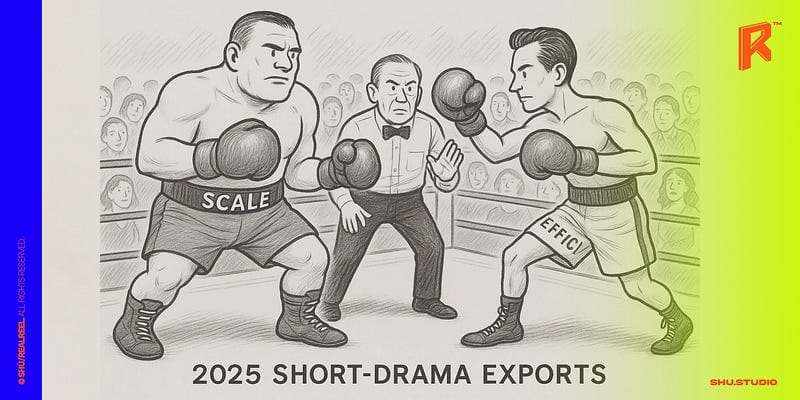Friday Briefing | 2025’s Vertical Short Drama Export: Scale Behemoths vs. Precision Hunters

Framing for market observers
The export wave is no longer a curiosity. It’s a bifurcated market with two winning logics: scale (library density + paid distribution) and efficiency (high RPD/LTV from narrowly targeted users). Understanding which game a company is playing explains the leaderboard and where margins come from.
Method note. Unless otherwise noted, app-level downloads/revenue/DAU in this piece come from a Sensor Tower cut for Jan 1–Sep 7, 2025 (ex-Mainland China) provided to us for analysis. Observations are our own and are not investment advice.
The crowded board
There are now 50+ apps competing for the same minutes and money. That density was predictable: mainstream coverage has pushed micro-dramas from niche format to export product, with consistent attention on ReelShort and DramaBox as category anchors.
The Scale war (China-led)
What scale looks like in 2025: industrialized story packaging, minute-long episodes, relentless A/B creative, and payment system design that meets users precisely where urgency peaks.
- ReelShort (Crazy Maple Studio / COL Group)
A conversion machine built on content density and disciplined paywalling. Public reporting has consistently tied its breakout to the combination of Chinese micro-drama craft and Silicon Valley distribution mechanics. - DramaBox
The “balanced sheet” challenger: broad audience acquisition, sticky DAU, and diversified monetization (IAP/subscription/ads/brand). External coverage has increasingly treated it as a co-anchor of the overseas market. - Fast followers
Titles like GoodShort (per our ST cut) show how quickly growth can be manufactured when a library engine and paid distribution lock in.
A second cluster complicates the map: high-download, ad-heavy players (e.g., Kuku TV / RapidTV in our dataset). Low IAP with strong top-of-funnel suggests an ad-first or market-seeding strategy — useful for destabilizing price expectations in IAP-centric apps.
On the scale side, whoever sustains library throughput + predictable UA wins the blended CAC/ARPU equation.
The Efficiency playbook: Drama Pops (Turkey)
Why it matters. In our 2025 sample, Drama Pops posts an RPD (~$5.66) that materially outperforms category anchors (ReelShort ~$2.59; DramaBox ~$1.60). That makes the unit economics work without nine-figure download totals. In other words: less quantity, more yield.
Who they are. Drama Pops is published by Codeway, a top Turkish mobile publisher with a portfolio built on tight creative testing and lifecycle monetization. The storefronts give us the basics (positioning, cadence, ratings), and Codeway’s product slate confirms ownership.

How the model shows up (signals across the quarter):
- Pulse buying vs. always-on UA. Visible install surges around specific titles suggest budget concentrates behind validated storylines rather than blanket reach. This is consistent with Codeway’s broader operating style in performance products.
- Fewer titles, tighter fit. Without a giant library, the portfolio compensates with clearer audience-to-premise fit and more conservative production scope, prioritizing titles that can carry high pay-intent pacing over volume.
- Friction-aware monetization. A lighter hand on interruptive ads and tighter placement of paid unlocks favors retention-led ARPU rather than short-term ad harvests — an approach echoed in recent U.S. coverage on what sustains the format.
Drama Pops embodies the precision hunter: not the loudest, but margin-efficient on a per-user basis. It’s the clearest international counter-model to the China-led scale thesis.
What the leaderboard is really telling us
- Two equilibria can coexist. The genre can support a mass library + paid UA equilibrium and an RPD-maximizing niche equilibrium. The former drives cultural visibility; the latter protects margins in capital-scarce contexts.
- Creative grammar is now standardized. Across both camps, we see the same micro-drama grammar: click-in premise + minute-beats + reliable cliffhanger economics, now widely understood by audiences and press.
- Narrative scope is widening. U.S. consumer reporting through late summer highlights diversification beyond “billionaire/forbidden alpha” tropes toward animation and male-skew titles, without abandoning the high-velocity twist economy.
What to watch next (4 quarters)
- Consolidation mechanics. A 50-app field is unsustainably noisy. Expect roll-ups or content-supply partnerships as distribution cost rises and creative costs normalize. Recent mainstream coverage calling out category scale will accelerate this.
- Up-market moves. As Western companies enter with different craft expectations, look for higher-finish mini-rooms and IP pipelines (webcomics → micro-drama → longer form). Press signals already point to that pipeline thinking.
- Studio engagement. The question is no longer if Hollywood notices, but how it experiments — sandbox labels, windowing tests, or acquisitions. Business media is now treating the U.S. market size as non-trivial.
- Tooling & AI creep. Expect AI to expand from auxiliary tasks (copy/boards/voice) into limited live-action augmentation. The production economics that newsrooms cite, low absolute budgets with outsized returns, invite tooling pressure.
First half: China-led scale industrialized the grammar and distribution.
Second half: Efficiency models like Drama Pops prove the unit economics don’t require a billion-view firehose, if story selection, pacing, and monetization are engineered for value, not volume. The export story is no longer about whether micro-dramas “count.” It’s about which operating system you choose to run.






